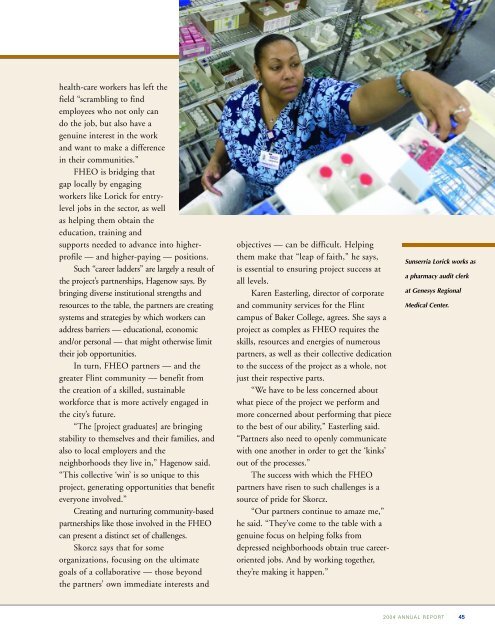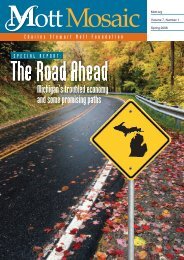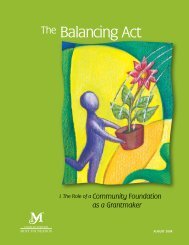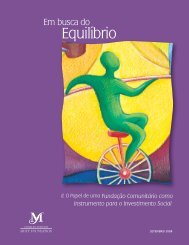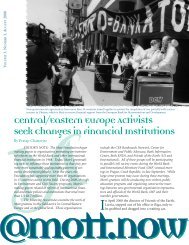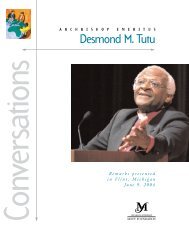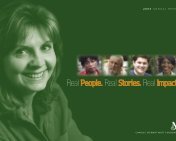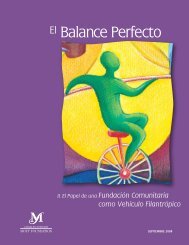Annual Report 2004 - Charles Stewart Mott Foundation
Annual Report 2004 - Charles Stewart Mott Foundation
Annual Report 2004 - Charles Stewart Mott Foundation
You also want an ePaper? Increase the reach of your titles
YUMPU automatically turns print PDFs into web optimized ePapers that Google loves.
health-care workers has left the<br />
field “scrambling to find<br />
employees who not only can<br />
do the job, but also have a<br />
genuine interest in the work<br />
and want to make a difference<br />
in their communities.”<br />
FHEO is bridging that<br />
gap locally by engaging<br />
workers like Lorick for entrylevel<br />
jobs in the sector, as well<br />
as helping them obtain the<br />
education, training and<br />
supports needed to advance into higherprofile<br />
— and higher-paying — positions.<br />
Such “career ladders” are largely a result of<br />
the project’s partnerships, Hagenow says. By<br />
bringing diverse institutional strengths and<br />
resources to the table, the partners are creating<br />
systems and strategies by which workers can<br />
address barriers — educational, economic<br />
and/or personal — that might otherwise limit<br />
their job opportunities.<br />
In turn, FHEO partners — and the<br />
greater Flint community — benefit from<br />
the creation of a skilled, sustainable<br />
workforce that is more actively engaged in<br />
the city’s future.<br />
“The [project graduates] are bringing<br />
stability to themselves and their families, and<br />
also to local employers and the<br />
neighborhoods they live in,” Hagenow said.<br />
“This collective ‘win’ is so unique to this<br />
project, generating opportunities that benefit<br />
everyone involved.”<br />
Creating and nurturing community-based<br />
partnerships like those involved in the FHEO<br />
can present a distinct set of challenges.<br />
Skorcz says that for some<br />
organizations, focusing on the ultimate<br />
goals of a collaborative — those beyond<br />
the partners’ own immediate interests and<br />
objectives — can be difficult. Helping<br />
them make that “leap of faith,” he says,<br />
is essential to ensuring project success at<br />
all levels.<br />
Karen Easterling, director of corporate<br />
and community services for the Flint<br />
campus of Baker College, agrees. She says a<br />
project as complex as FHEO requires the<br />
skills, resources and energies of numerous<br />
partners, as well as their collective dedication<br />
to the success of the project as a whole, not<br />
just their respective parts.<br />
“We have to be less concerned about<br />
what piece of the project we perform and<br />
more concerned about performing that piece<br />
to the best of our ability,” Easterling said.<br />
“Partners also need to openly communicate<br />
with one another in order to get the ‘kinks’<br />
out of the processes.”<br />
The success with which the FHEO<br />
partners have risen to such challenges is a<br />
source of pride for Skorcz.<br />
“Our partners continue to amaze me,”<br />
he said. “They’ve come to the table with a<br />
genuine focus on helping folks from<br />
depressed neighborhoods obtain true careeroriented<br />
jobs. And by working together,<br />
they’re making it happen.”<br />
Sunserria Lorick works as<br />
a pharmacy audit clerk<br />
at Genesys Regional<br />
Medical Center.<br />
<strong>2004</strong> ANNUAL REPORT<br />
45


